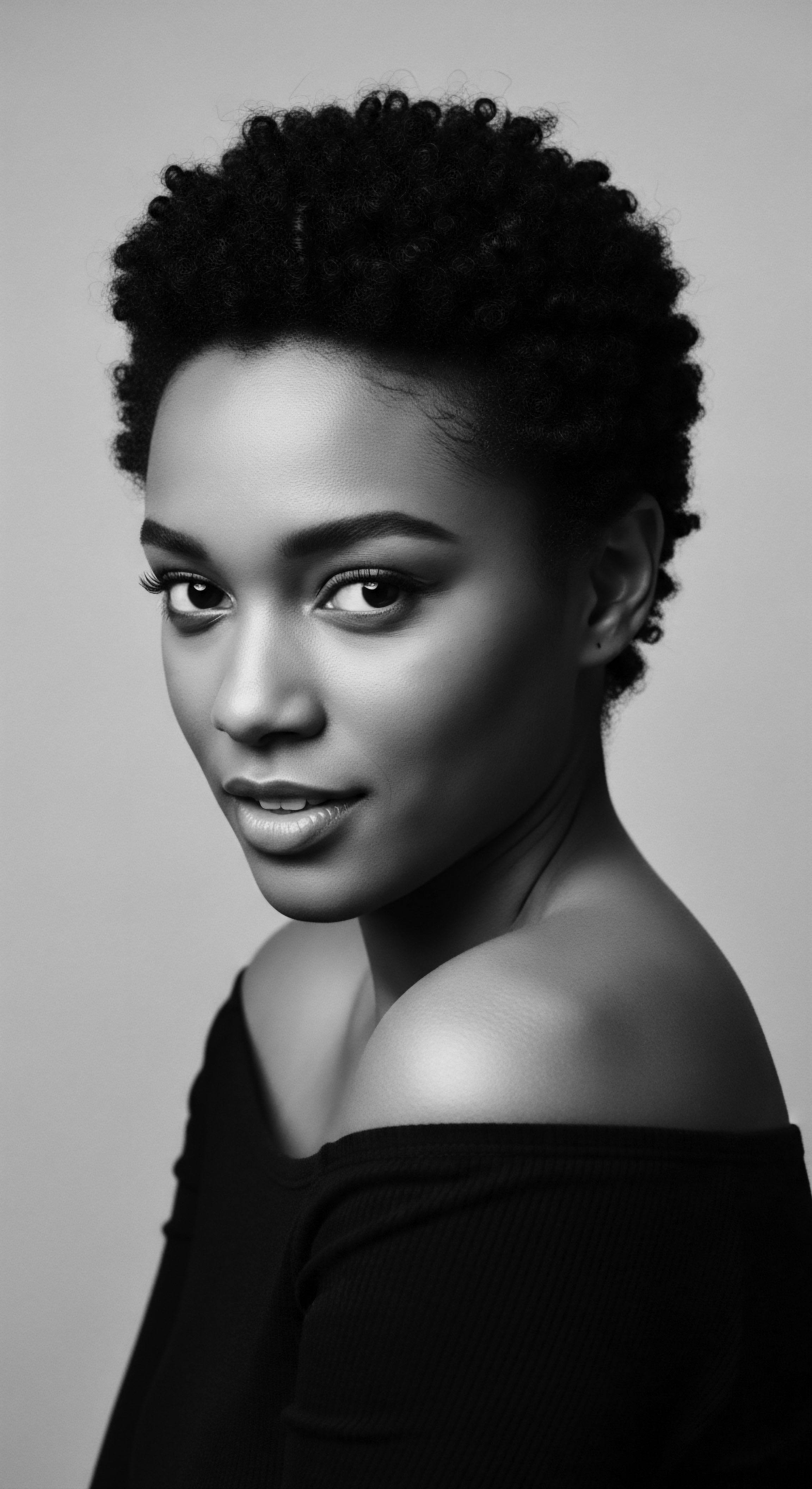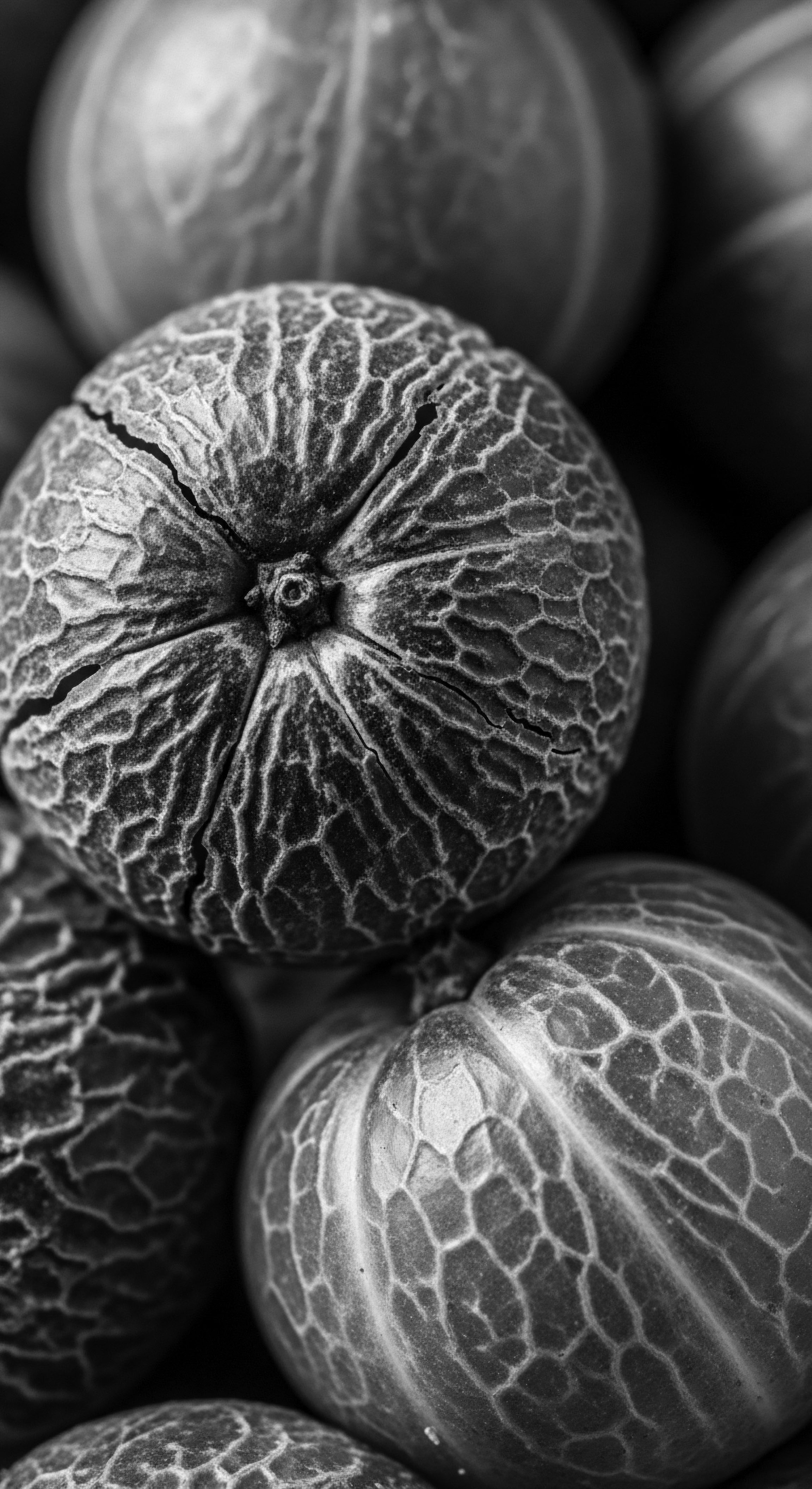
Roots
To truly understand textured hair identity, we must first turn our attention to the ancient practices of cleansing. It is in these foundational rituals that the very essence of hair care, communal bonds, and individual expression began to intertwine, laying down enduring pathways to self-regard. Long before modern formulations graced our shelves, our ancestors observed the world around them, discerning the restorative properties of earth and flora. Cleansing traditions, far from being mere hygiene routines, emerged as profound ceremonies.
They spoke to the spiritual connection between hair and person, a belief system holding that the hair, as the highest point of the body, was a conduit to the divine. This understanding, steeped in ancestral wisdom, shaped the earliest approaches to maintaining hair health and appearance, directly influencing how textured hair was perceived and valued through generations.
Consider the historical perspectives on hair care practices among people of African ancestry, where hair was not just an aesthetic feature. It served as a means of identification, classification, and communication, acting as a medium to connect with the spiritual realm in many African societies. Intricate styles, such as elaborate cornrows and braiding, required meticulous care, often incorporating natural butters, herbs, and powders for moisture retention. This commitment to hair care underscored its ceremonial and social importance.

Hair’s Earliest Language
The very structure of textured hair, with its unique coils and curls, often presents particular needs for moisture and gentle handling. Early cleansing methods, therefore, were inherently gentle, devised long before the advent of harsh, stripping agents common in modern commercial products. Ancient civilizations, across diverse landscapes, discovered the purifying properties of nature’s bounty.
Clay, plant extracts, and essential oils were among the first cleansers. These early innovators established a heritage of hair care that celebrated the deep connection between cultural practices and the land.
Cleansing traditions were not merely about hygiene; they were ancient ceremonies, reflecting a spiritual connection between hair and identity, particularly for those with textured strands.
For instance, African Black Soap, known as “ose dudu” in Yoruba, traces its origins to West Africa. This dark, plant-based cleanser, handcrafted using time-honored methods passed down through generations, combines elements such as plantain skins, cocoa pods, shea butter, and palm oil. It provided a gentle yet effective cleaning, respecting the hair’s natural oils while removing impurities. The crafting of African Black Soap was a communal enterprise, symbolizing the community’s environmental consciousness and their collective endeavor to use the land’s offerings.

Botanical Allies for Hair Cleansing
Across different continents, various cultures turned to the earth for their cleansing needs. These traditions prioritized preservation of the hair’s inherent qualities, understanding that strength came from gentle applications and natural nourishment.
- Rhassoul Clay ❉ This natural mineral clay, gathered from Morocco’s Atlas Mountains, excels at drawing out impurities and toxins without stripping hair of its natural oils. It has been used as a shampoo, mask, and conditioner, offering benefits like detangling, clearing blocked scalp pores, and soothing scalp issues.
- Yucca Root ❉ Native American tribes utilized this ingredient to create a natural shampoo. The root was crushed and combined with water to yield a soapy lather, leaving hair clean and conditioned.
- Shikakai ❉ From ancient Indian Ayurveda, this “fruit for hair” is rich in saponins, natural compounds that produce a mild lather. It cleanses without stripping natural oils, promotes a smooth texture, and helps reduce breakage.
- Soapberries (Reetha) ❉ These tropical trees, native to India, also contain saponins in their fruit pulp, acting as natural surfactants to produce a lather. This extract cleanses and leaves hair soft and manageable.
Beyond these, historical cleansing methods sometimes included raw eggs, which, as modern science reveals, contain lecithin, an emulsifier that can cut through grease and dirt, leaving hair clean. The historical reluctance to use harsh soaps on hair, rooted in a desire to preserve natural oils, aligns with contemporary understanding of textured hair’s moisture needs. These ancestral methods underscore a profound, inherited understanding of hair’s delicate biological balance.
| Traditional Cleanser African Black Soap |
| Ancestral Use Hair, body, and face cleansing; medicinal and spiritual purposes in West Africa. |
| Benefit for Textured Hair Heritage Gentle, non-stripping cleaning; rich in vitamins and antioxidants for scalp nourishment. |
| Traditional Cleanser Rhassoul Clay |
| Ancestral Use Hair cleansing, masks, conditioners; impurity removal, scalp soothing. |
| Benefit for Textured Hair Heritage Remineralizing and moisturizing; helps detangle and improve hair elasticity for coils. |
| Traditional Cleanser Shikakai |
| Ancestral Use Hair and scalp cleansing; promoting hair health in ancient Indian Ayurveda. |
| Benefit for Textured Hair Heritage Gentle lathering without stripping oils; aids in detangling and hair strengthening. |
| Traditional Cleanser These ancestral agents speak to an enduring heritage of hair care that prioritizes natural balance over harsh intervention. |

Ritual
Cleansing textured hair extended beyond mere physical acts; it became a ritual, a communal undertaking that reinforced bonds and transmitted cultural knowledge. These cleansing rituals were often performed within family circles, serving as moments for intergenerational exchange, where older hands guided younger ones in the nuances of care. The practices were infused with a reverence for the hair, recognizing its vulnerability and its power as a marker of identity. The very act of washing, conditioning, and preparing hair for styling was a language spoken through touch, scent, and shared presence.

Cleansing as a Communal Practice?
In pre-colonial African societies, hair styling was often an elaborate, time-consuming process that included washing, combing, oiling, braiding, or twisting. These sessions were not solitary endeavors; they were viewed as social opportunities to bond with family and friends, a tradition that persists today. The communal aspect of cleansing cemented its place as a cornerstone of social life.
Children learned from their elders, observing the careful methods of applying natural cleansers and emollients, feeling the patient hands working through their coils. This shared experience instilled a sense of belonging and a deep respect for their hair’s inherent beauty and unique qualities.
The regularity of these cleansing rituals also evolved in response to environmental conditions and lifestyle. Historically, daily washing, as understood by modern practices, was uncommon. People in various historical contexts, including those with textured hair, often used very gentle washing techniques, understanding that frequent, harsh cleaning could strip natural oils.
Their scalps and hair did not overproduce oils because they were not constantly being stripped, allowing for less frequent yet still effective cleansing. This approach was a reflection of the deep ecological wisdom embedded in ancestral practices, where resources like water were valued and used mindfully.
The communal wash day, often stretching hours, served as a profound space for storytelling, cultural instruction, and the quiet transfer of ancestral wisdom from one generation to the next.

The Wash Day Ceremony
For many individuals with textured and Afro-hair, “wash day” is not a quick affair; it is a significant routine, a ceremony that preserves the hair. It involves a careful selection of products, precise application methods, and thoughtful grooming techniques, often conducted in private spaces, though its origins lie in community. There is a common understanding that Black hair, despite its appearance of density, is fragile and susceptible to breakage. This knowledge, passed down through time, emphasizes the need for consistent wash day routines to promote healthy growth.
A typical ancestral cleansing sequence might have included:
- Pre-Cleansing Treatments ❉ Applying natural oils or butters to loosen dirt and protect strands before a water-based wash. This respected the hair’s need for moisture.
- Gentle Washing with Botanicals ❉ Using concoctions derived from African Black Soap, clays, or herbal infusions that cleaned without harsh chemicals.
- Detangling with Care ❉ Utilizing fingers or wide-tooth combs crafted from wood or bone, patiently working through coils while wet or lubricated, minimizing breakage.
- Rinsing with Intention ❉ Often with specialized rinses like fermented rice water or herbal teas to balance pH and add shine, a practice still resonant today.
These practices underscore a holistic view of hair care that recognized the delicate balance required to maintain textured hair’s health. The focus remained on nourishment and protection, rather than aggressive cleaning that could compromise the hair’s structural integrity. Even today, advice for healthy black hair includes washing once a week or every other week to prevent product buildup and reduce dryness.

Tools and Traditions of Care
The tools used in these rituals were also extensions of cultural heritage. Combs, often hand-carved from wood, bone, or ivory, were more than utilitarian items. Archaeological discoveries from Kush and Kemet (present-day Sudan and Egypt) reveal combs buried with their owners, signifying their sacred nature. These combs often bore symbols indicating tribal identity, social rank, fertility, and even protective meanings.
The selection of tools for cleansing and subsequent styling was a mindful act, steeped in the wisdom of generations. The historical use of “wool carding tools” to detangle hair by enslaved people in North America, and the creation of combs from wood or metal scraps when traditional tools were inaccessible, stand as powerful testaments to adaptation and perseverance in maintaining hair care practices against incredible odds. This resourcefulness speaks volumes about the enduring dedication to hair as an element of self and collective identity, even in the most challenging circumstances.

Relay
The relay of cleansing traditions through time reveals more than just a continuum of practices; it lays bare the profound interplay between hair, identity, and the sweeping currents of history. Cleansing rituals became a silent language of resistance, a means for people of African descent to maintain a connection to their ancestral heritage even when stripped of nearly everything else. The meticulous care, the ingredients chosen, and the communal aspect of these traditions became acts of defiance against forces seeking to erase identity. This enduring legacy offers a powerful lens through which to understand the resilience of textured hair identity.

Cultural Preservation Through Cleansing
During the transatlantic slave trade, one of the first and most brutal acts inflicted upon enslaved Africans was the shaving of their heads. This was a calculated psychological tactic, an act of dehumanization intended to strip away their connection to their culture, lineage, and spiritual identity. When hair grew back, access to native tools, herbal treatments, and oils was absent. Yet, traditions did not vanish; they adapted.
Hair that was once a source of pride became matted and tangled, often hidden under scarves. Despite these immense challenges, knowledge of hair care was passed down, sometimes in whispers, rituals of quiet defiance. This era saw the improvised use of ingredients like cornmeal as a dry shampoo and kerosene or bacon grease as conditioners, a stark demonstration of perseverance in maintaining hair hygiene and health with whatever was available.
Cleansing rituals, transmuted by harsh realities, transformed into acts of resilience, silently passing down ancestral knowledge and reaffirming identity through generations.
The very definition of “clean” and “healthy” hair was reshaped under the shadow of Eurocentric beauty standards. Straight hair and lighter skin afforded social and economic advantages, leading to the adoption of practices like hot combs and lye-based chemical relaxers for assimilation. These chemical processes, which gained traction in the early 20th century, fundamentally altered the natural structure of textured hair. The use of relaxers, which contain strong alkali agents like sodium hydroxide, effectively “relaxes” the natural curls by causing controlled damage to the hair’s protein structure.
This practice, while providing a pathway to conformity, often came at the cost of hair damage and health concerns. For instance, a 2023 survey indicated that Black respondents reported the most frequent use of chemical straighteners compared to other races, with 61% reporting they used them because they felt “more beautiful with straight hair”. This statistic profoundly illustrates how external pressures influenced cleansing and styling choices, impacting self-perception within the community.

Science Validates Ancestral Practice?
In a fascinating historical turn, modern scientific understanding often validates the intuitive wisdom of ancestral cleansing practices. The concept of Co-Washing, for instance, which involves washing hair with a conditioning cleanser rather than shampoo, has become a popular method for textured hair to retain moisture. This approach mirrors the historical avoidance of harsh, stripping detergents, prioritizing the hair’s natural moisture balance. The deliberate choice to use conditioning agents for cleaning, rather than aggressive surfactants, reflects an ancient understanding of textured hair’s delicate needs, now confirmed by dermatological recommendations which suggest washing textured hair weekly or bi-weekly to prevent dryness and product buildup, often with conditioner use.
The chemical makeup of many traditional cleansers, such as the saponins found in Shikakai or Reetha, act as natural surfactants that clean delicately without stripping essential oils. This aligns with current scientific understanding of what benefits textured hair, which is prone to dryness due to its coiled structure limiting the natural sebum’s ability to travel down the hair shaft. The return to natural hair movements in recent decades represents a powerful reclamation of ancestral identity and a rejection of imposed beauty ideals. The decline in chemical relaxer sales (a 26% decrease from 2010 to 2015) alongside an increase in products for natural hair, speaks to a collective shift towards honoring inherent textures.
- African Black Soap ❉ Contains plant ash for saponification, palm oil rich in antioxidants, shea butter for moisture, and coconut oil for cleansing and healing.
- Chebe Powder ❉ Used by women in Chad, known for increasing hair thickness and retaining moisture, it balances scalp pH and provides deep conditioning.
- Ghee (Clarified Butter) ❉ Historically used in Ethiopian communities for hair care, it moisturizes and nourishes the hair.
These ingredients, rooted in diverse ancestral lands, illustrate a global heritage of discerning nature’s offerings for hair health. The very act of choosing these materials, preparing them, and applying them was a quiet affirmation of self, lineage, and cultural continuity against prevailing pressures. The knowledge passed through generations, sometimes orally, sometimes through shared actions, has provided a foundation for contemporary hair care that seeks to respect and preserve the unique qualities of textured hair.

Reflection
Cleansing traditions, from their primal beginnings to their modern iterations, echo across centuries, deeply influencing what it means to possess textured hair. They tell a continuous story of ingenuity, resilience, and profound connection to heritage. Every gentle wash, every chosen botanical, every communal moment of care, has sculpted not only the physical strands but also the spirit of identity.
These practices stand as a living archive, safeguarding ancestral wisdom and affirming the inherent beauty of coils, curls, and waves. They remind us that the Soul of a Strand is inextricably bound to the collective memory of a people, continuously reclaiming and celebrating its true form.

References
- Byrd, A. & Tharps, L. L. (2001). Hair Story ❉ Untangling the Roots of Black Hair in America. St. Martin’s Press.
- Daily, L. M. (2023). What Every Dermatologist Must Know About the History of Black Hair. Clinics in Dermatology.
- Draelos, Z. K. (2010). Cosmetic Dermatology ❉ Products and Procedures. Blackwell Publishing.
- Grier, S. A. & Davis, M. H. (2018). Black Hair ❉ A Cultural History. University Press of Florida.
- Mercer, K. (1994). Welcome to the Jungle ❉ New Positions in Black Cultural Studies. Routledge.
- Patel, N. & Sharma, V. (2019). Traditional Indian Hair Care Practices. Journal of Traditional Medicine and Clinical Naturopathy.
- Robinson, J. (2020). The Science of Black Hair ❉ A Comprehensive Guide to Textured Hair Care. Self-Published.
- Sinha, A. (2021). Ayurvedic Hair Care ❉ Ancient Wisdom for Modern Times. Lotus Press.
- Sparrow, D. (2015). African Americans and the New Hair Care Revolution. Journal of Cosmetology & Trichology.
- Walker, L. E. (1913). Madam C. J. Walker’s System of Hair Culture. (Original publication).
